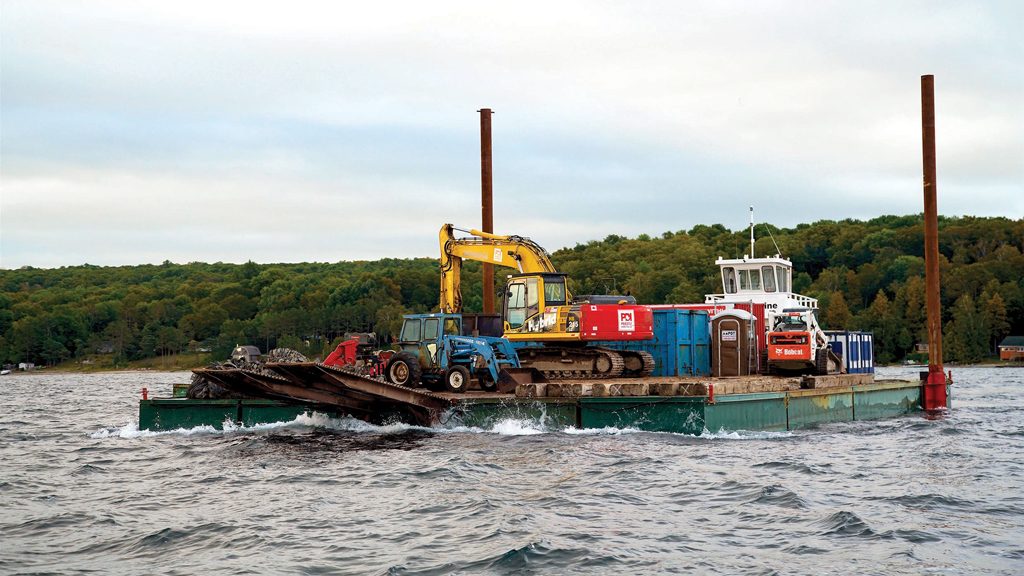When Priestly Demolition arrived on isolated Hope Island in Georgian Bay to demolish a dilapidated lighthouse, some crew members felt a sense of unease. Also known as Snake Island, the site offered plenty of the reptiles to dog the steps of unwary workers. And then there were the legends about ghosts.
The lighthouse was built on the northeast tip of the island in 1884 at a cost of $1,864. The light at the top of the 57-foot tower could be seen for 12 miles in any direction. Legend says that the island’s third lighthouse keeper, John Hoar, confessed on his deathbed to killing two fishermen, Francois Marchildon and William Lacourse, who disappeared near Hope Island in the early 1890s. Marchildon’s relatives searched the island in 1906 but found no bodies. However, visitors to the island have since reported seeing strange lights hovering above the water and hearing disembodied voices floating through the fog.
The lighthouse had been declared a surplus property by owner Public Works and Government Services Canada. A metal light tower had long since replaced the original lighthouse and most of the buildings had fallen into ruin. The low-bid contract to demolish the buildings on the property was awarded to Priestly for $562,627. WSP acted as project consultant.
“On the face of it, this was a straightforward demolition job,” says Daniel Campkin, project manager with Priestly. “But because this project was located on an uninhabited island well off the mainland, we had to do a significant amount of planning to meet logistical challenges.”
All equipment and supplies were to be transported by barge from the Christian Island Ferry launch, about 12 kilometres across Georgian Bay. Priestly contracted Galcon Marine to provide the modular barge, which arrived in eight truckloads from Sarnia and Toronto in early September 2017.
Priestly supplied a 90-tonne crane to assemble the barge segments alongside Galcon personnel. It took Priestly workers a week to bolt the components together, while a crew of five performed asbestos abatement on the island. The completed barge measured 90 by 40 feet and five feet deep.
A tugboat towed the barge to and from the island, delivering: a sea can site trailer; three excavators; grapple, hammer and bucket attachments; a Bobcat; a bush hog; 16 40-yard roll off containers; and a portable restroom. Once near shore, two hydraulic towers were lowered into the bay bottom to anchor the craft.
“We knew the good weather wouldn’t last forever so we had to make the most of our time,” says Campkin. “Transportation time was always a factor. The work boat we used to transport personnel took from 20 minutes to half an hour to make the trip. The barge took several hours.”
Work included demolition, removal and disposal of the facility’s lighthouse, boathouse, fog house, generator building, wharf and two residences. It also included rough grading of the property and relocation of existing rip-rap along the shoreline.
“These buildings were in very rough shape,” says Campkin. “We could salvage only a few items, such as doors.”
Following the delivery of equipment, the barge was used to transport debris to the mainland — primarily wood, concrete and brick. On the best days, the barge could make the return trip twice, loading six bins each time and swapping full bins for empty ones on the mainland. On the worst, it couldn’t battle the waves and remained docked.

“Our final job was to grade the property to something approaching its natural state before the lighthouse was built,” Campkin says.
Work was completed at the end of October and the barge returned at the start of November.
Although no skeletal remains of lost fishermen were discovered on site, Campkin admits that he was sometimes affected by the island’s strange atmosphere.
“You’re working in places that were once hustling and bustling and now they’re silent,” he says.



Recent Comments
comments for this post are closed